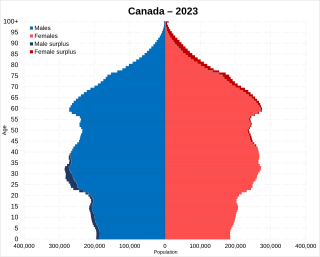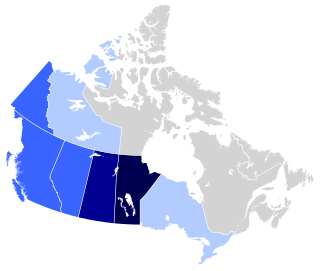
Statistics Canada conducts a country-wide census that collects demographic data every five years on the first and sixth year of each decade. The 2021 Canadian census enumerated a total population of 36,991,981, an increase of around 5.2 percent over the 2016 figure, Between 1990 and 2008, the population increased by 5.6 million, equivalent to 20.4 percent overall growth. The main driver of population growth is immigration. Between 2011 and May 2016, Canada's population grew by 1.7 million people, with immigrants accounting for two-thirds of the increase.

According to the 2021 Canadian census, over 450 "ethnic or cultural origins" were self-reported by Canadians. The major panethnic origin groups in Canada are: European (52.5%), North American (22.9%), Asian (19.3%), North American Indigenous (6.1%), African (3.8%), Latin, Central and South American (2.5%), Caribbean (2.1%), Oceanian (0.3%), and Other (6%). Statistics Canada reports that 35.5% of the population reported multiple ethnic origins, thus the overall total is greater than 100%.
Portuguese Canadians are Canadian citizens of full or partial Portuguese heritage or people who migrated from Portugal and reside in Canada. According to the 2016 Census, there were 482,610 or 1.4% of Canadians claimed full or partial Portuguese ancestry, an increase compared to 410,850 in 2006. Most Portuguese Canadians live in Ontario - 282,865 (69%), followed by Quebec 57,445 (14%) and British Columbia 34,660 (8%).
Haitian Canadians are Canadian citizens of Haitian descent or Haiti-born people who reside in Canada. As of 2016, more than 86% of Haitian Canadians reside in Quebec.

Russian Canadians comprise Canadian citizens of Russian heritage or Russians who immigrated to and reside in Canada. According to the 2021 Census, there were 548,140 Canadians who claimed full or partial Russian ancestry. The areas of Canada with the highest percentage population of Russian Canadians are the Prairie Provinces.
Laotian Canadians, are Canadian citizens of Laotian origin or descent. In the 2016 Census, 24,580 people indicated Laotian ancestry. Bilateral relations between Canada and Laos were established in 1954 with the formalization of the independence of the Kingdom of Laos from France. In August 2015, Canada's first resident diplomat opened the Office of the Embassy of Canada in Vientiane, Laos.
Trinidadian and Tobagonian Canadians are Canadian citizens who are fully or partially of Trinidadian and Tobagonian descent or persons having those origins and having Canadian citizenship. There were 105,965 Trinidadian and Tobagonian Canadians in 2021, with the majority of them living in Toronto, Peel Region, and Durham Region.
Romanian Canadians are Canadian citizens of Romanian descent or Romania-born people who reside in Canada.
Danish Canadians are Canadian citizens of Danish ancestry. According to the 2006 Census, there were 200,035 Canadians with Danish background, 17,650 of whom were born in Denmark.

Ontario, one of the 13 provinces and territories of Canada, is located in east-central Canada. It is Canada's most populous province by a large margin, accounting for nearly 40 percent of all Canadians, and is the second-largest province in total area. Ontario is fourth-largest in total area when the territories of the Northwest Territories and Nunavut are included. It is home to the nation's capital city, Ottawa, and the nation's most populous city, Toronto.
Welsh Canadians are Canadian citizens of Welsh descent or Wales-born people who reside in Canada.
Barbadian Canadian or Bajan Canadians are Canadian citizens of Barbadian descent or Barbados-born people who reside in Canada. According to the 2016 Census 37,780 Canadians claimed full or partial Barbadian ancestry. Barbadian Canadians have the highest median income and the lowest incidence of poverty among Black Canadian groups. Barbadians first start migrating to Nova Scotia in the early 1900s settling largely in the neighbourhood of Whitney Pier in Sydney. In Cape Breton, they established chapters of the United Negro Improvement Association and the African Orthodox Church. As of 2016, over 70% of the Bajan population in Canada resides in Ontario.

Alberta has experienced a relatively high rate of growth in recent years, due in large part to its economy. Between 2003 and 2004, the province saw high birthrates, relatively high immigration, and a high rate of interprovincial migration when compared to other provinces. Approximately 81% of the population live in urban areas and only about 19% live in rural areas. The Calgary–Edmonton Corridor is the most urbanized area in Alberta and is one of Canada's four most urban regions. Many of Alberta's cities and towns have also experienced high rates of growth in recent history. From a population of 73,022 in 1901, Alberta has grown to 4,262,635 in 2021 and in the process has gone from less than 1.5% of Canada's population to 11.5%. It is the fourth most populated province in Canada. Between the 2016 and 2021 censuses, the Alberta population grew by 4.8%.
Jamaican Canadians are Canadian citizens of Jamaican descent or Jamaican-born permanent residents of Canada. The population, according to Canada's 2021 Census, is 249,070. Jamaican Canadians comprise about 30% of the entire Black Canadian population.

Mexican Canadians are Canadian citizens of Mexican origin, either through birth or ethnicity, who reside in Canada. According to the 2021 Census, 55,380 Canadians indicated they were of full or partial Mexican ancestry. They are part of the broader Latin American Canadian community.
Egyptian Canadians are Canadian citizens of Egyptian descent, first-generation Egyptian immigrants, or descendants of Egyptians who emigrated to Canada. According to the 2011 Census there were 73,250 Canadian citizens who are from Egypt, having an increase compared to those in the 2006 Census.
Cambodian Canadians are Canadians of Cambodian ethnic origin or descent. There are a total of 38,490 Canadian Cambodians, most of whom reside in Toronto and Montreal.
Belgian Canadians are Canadian citizens of Belgian ancestry or Belgium-born people who reside in Canada. According to the 2011 census there were 176,615 Canadians who claimed full or partial Belgian ancestry. It encompasses immigrants from both French and Dutch-speaking parts of Belgium.
Ghanaian Canadians are Canadians of full or partial Ghanaian ancestry. Ghanaians who became naturalized citizens of Canada preferably refer to themselves as Ghanaian Canadians.




